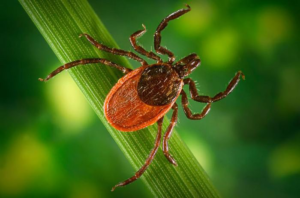 How ticks find their hosts
How ticks find their hosts
Ticks find their hosts by detecting animals´ breath and body odors, or by sensing body heat, moisture, and vibrations. Some species can even recognize a shadow. In addition, ticks pick a place to wait by identifying well-used paths. Then they wait for a host, resting on the tips of grasses and shrubs. Ticks can’t fly or jump, but many tick species wait in a position known as “questing”.
While questing, ticks hold onto leaves and grass by their third and fourth pair of legs. They hold the first pair of legs outstretched, waiting to climb on to the host. When a host brushes the spot where a tick is waiting, it quickly climbs aboard. Some ticks will attach quickly and others will wander, looking for places like the ear, or other areas where the skin is thinner.
How ticks spread disease
Ticks transmit pathogens that cause disease through the process of feeding.
- Depending on the tick species and its stage of life, preparing to feed can take from 10 minutes to 2 hours. When the tick finds a feeding spot, it grasps the skin and cuts into the surface.
- The tick then inserts its feeding tube. Many species also secrete a cement-like substance that keeps them firmly attached during the meal. The feeding tube can have barbs which help keep the tick in place.
- Ticks also can secrete small amounts of saliva with anesthetic properties so that the animal or person can’t feel that the tick has attached itself. If the tick is in a sheltered spot, it can go unnoticed.
- A tick will suck the blood slowly for several days. If the host animal has a bloodborne infection, the tick will ingest the pathogens with the blood.
- Small amounts of saliva from the tick may also enter the skin of the host animal during the feeding process. If the tick contains a pathogen, the organism may be transmitted to the host animal in this way.
- After feeding, most ticks will drop off and prepare for the next life stage. At its next feeding, it can then transmit an acquired disease to the new host.
How to Avoid Ticks:
- Wear light-colored clothing.
- Tuck your pants into your socks.
- Tuck your shirt into your pants.
- Wear a hat.
- Spray your shoes, socks, belt-line, collar and hat with a permethrin-containing tick repellent. Permethrin is not for use on exposed skin; its effectiveness is reduced and even eliminated by skin oils.**
- Use insect repellant products containing DEET for skin applications. Though not 100% effective, they can help.
- Do a tick check after walking in high-risk areas.
- Put any clothes that might have live ticks on them into a hot dryer for ten minutes to kill all insects.
** Once it is sprayed on clothing, permethrin becomes odorless and can last for several weeks with a single application; even after washing. Once it is applied, most ticks will curl up and fall off if they make contact, and will eventually die if there is prolonged exposure.
Permethrin is an insecticide derived from a chemical found in the chrysanthemum family of plants. It is a spray that is used on clothes only, and is deactivated and made less effective by the oils on our skin.
The story of DEET: http://www.popsci.com/article/science/deet-safe-use
Recommended Product Descriptions/Sources:
Clothing Application (Permethrin)
https://sawyer.com/products/permethrin-premium-insect-repellent/
Skin Application (With Deet)
